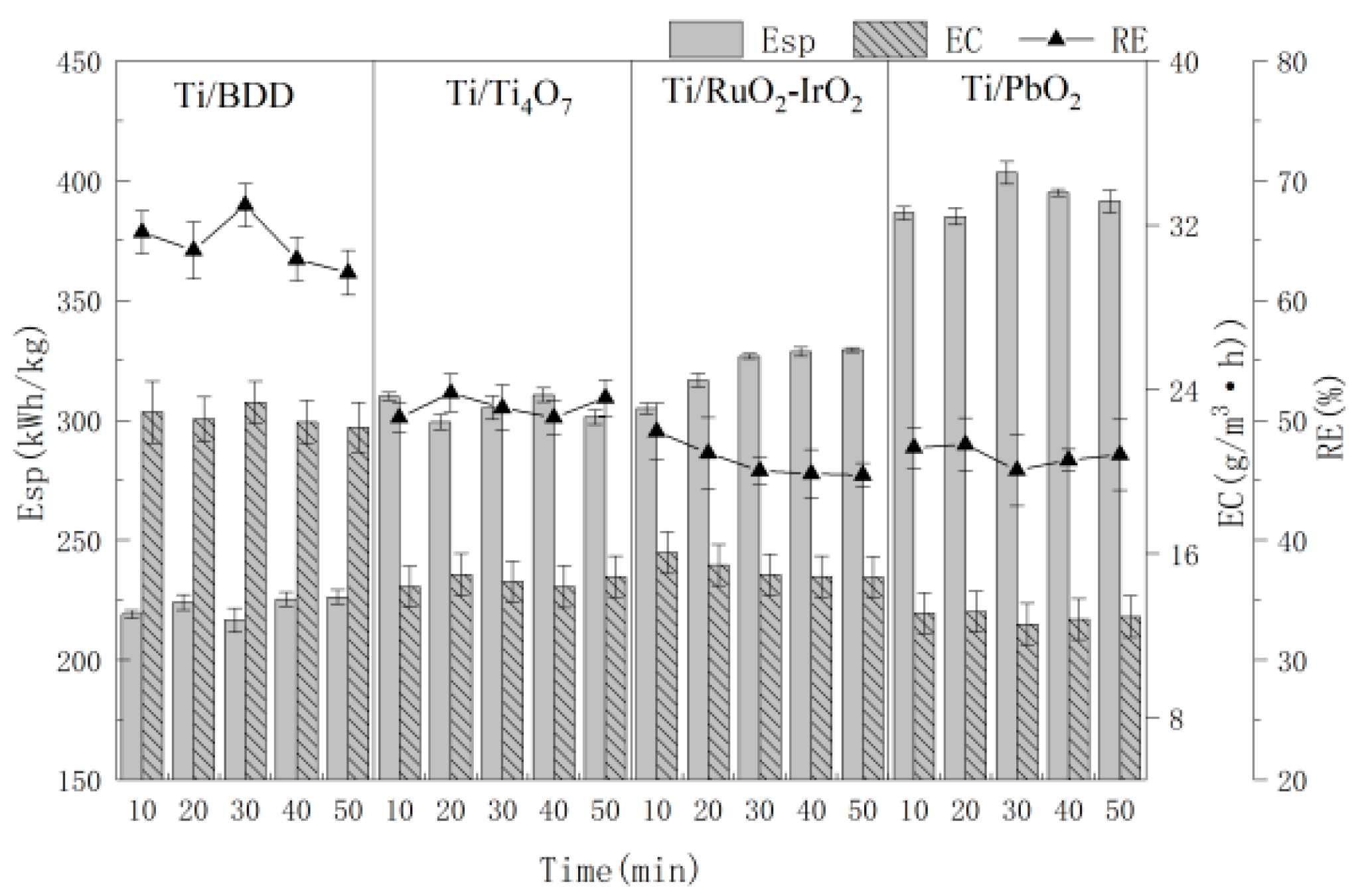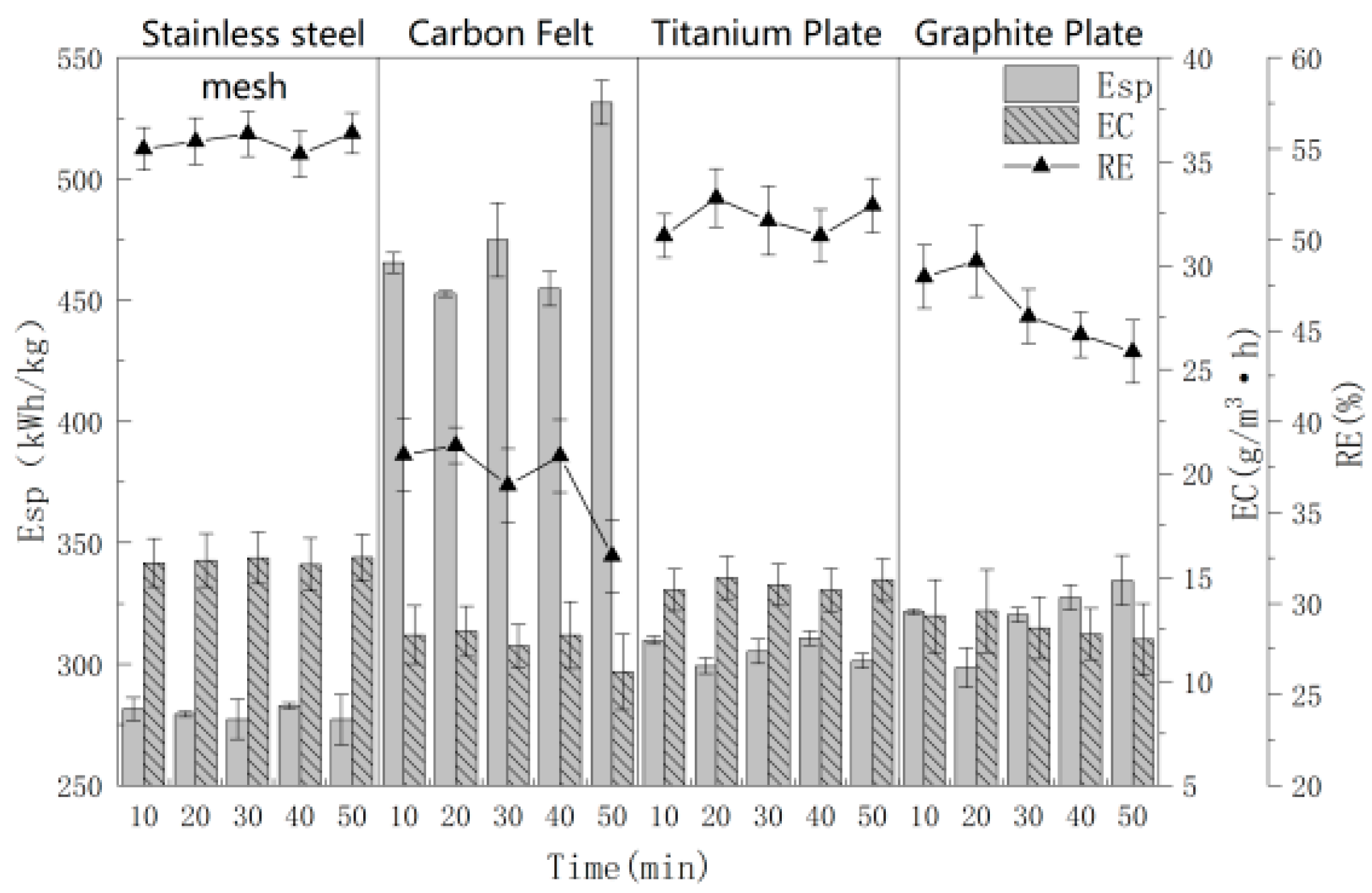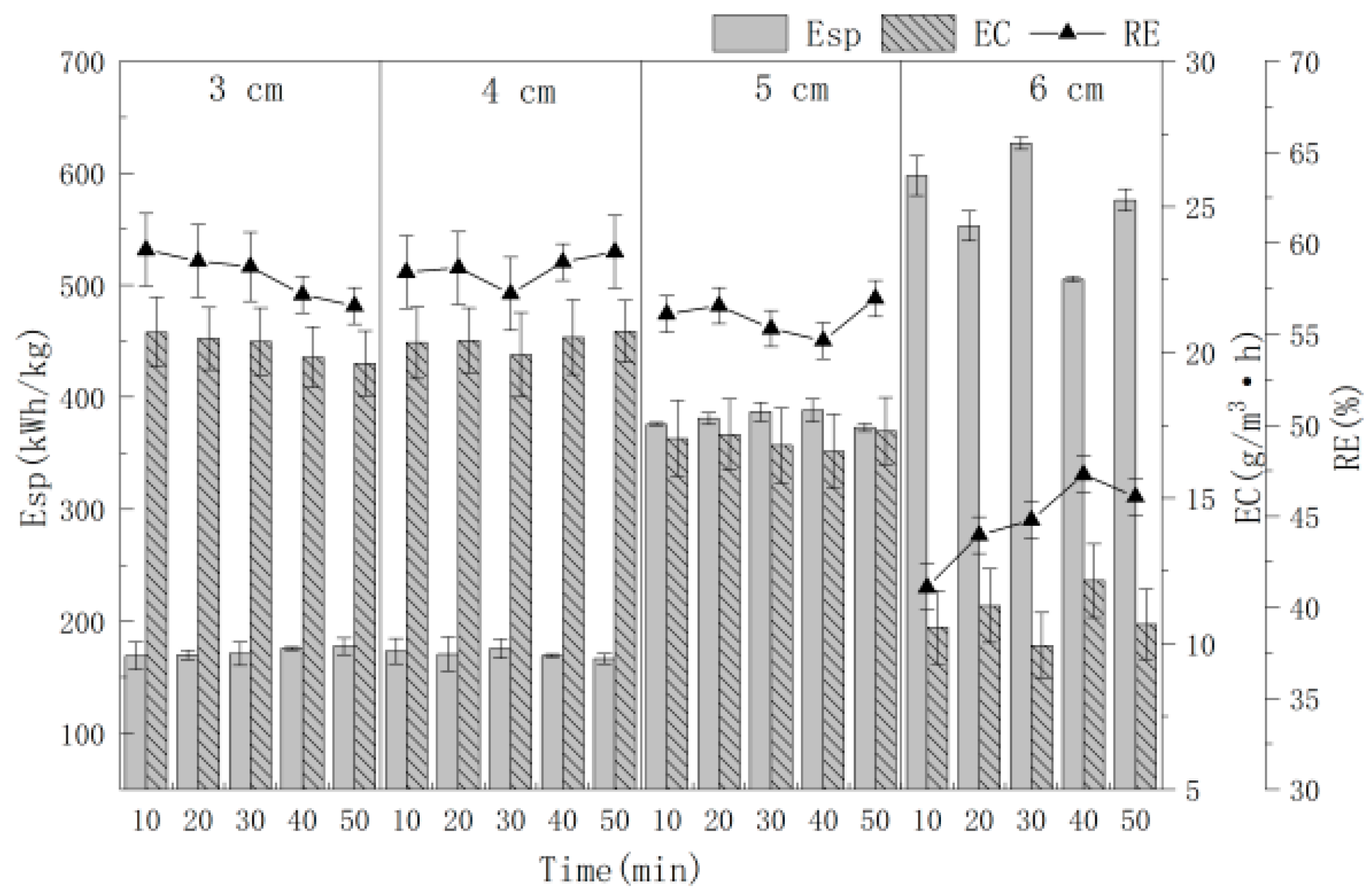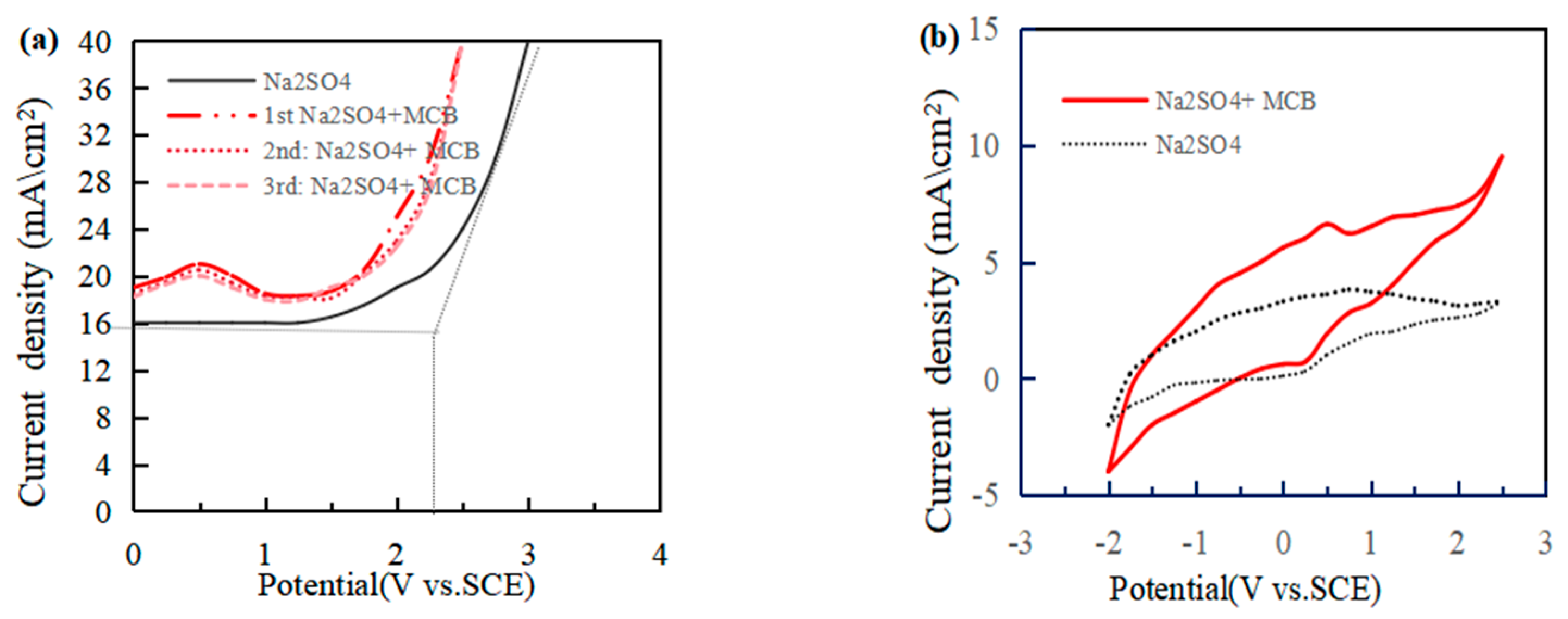Treatment of Monochlorobenzene from Polymers Process through Electrochemical Oxidation
Abstract
1. Introduction
2. Materials and Methods
2.1. Construction of Electrochemical System
2.2. Experimental Method
2.2.1. Single-Factor Experiment
| RE = (Cin − Cout)/Cin × 100% |
| EC = (Cin − Cout)Q/V |
| Esp = UI/(Cin − Cout)Q |
| CD = I/A |
2.2.2. Response-Surface Optimization Experiment
2.3. Electrode Material
2.4. Analysis Method
2.5. Electrochemical Test
3. Results
3.1. Effect of Anode Materials
3.2. Effect of Cathode Materials
3.3. Effect of Electrolyte Concentration
| 2Cl− → Cl2(aq) + 2e− |
| Cl2(aq) + H2O → HClO + Cl− + H+ (the chloride ion cycle) |
| HClO ↔ ClO− + H+ (in equilibrium) |
| O2 + 2H+ + 2e− → H2O2 |
3.4. Effect of Current Density
3.5. Effect of Electrode Distance
3.6. Optimize Process Parameters with Response-Surface Methodology
3.6.1. Response-Surface Experiment Results and Variance Analysis
3.6.2. Interaction Effect of Electrolyte Concentration and Current Density
3.6.3. Verification of the Model
3.7. Characterization of the Electrochemical of Electrode
4. Conclusions
Author Contributions
Funding
Institutional Review Board Statement
Data Availability Statement
Conflicts of Interest
References
- Tian, H.L.; Quan, Y.; Yin, Z.H.; Yin, C.R.; Fu, Y. Bioelectrochemical Purification of Biomass Polymer Derived Furfural Wastewater and Its Electric Energy Recovery. Polymers 2023, 15, 3422. [Google Scholar] [CrossRef] [PubMed]
- Yang, C.Y.; Wu, H.; Cai, M.Y.; Zhou, Y.T.; Guo, C.Y.; Han, Y.; Zhang, L. Valorization of Biomass-Derived Polymers to Functional Biochar Materials for Supercapacitor Applications via Pyrolysis: Advances and Perspectives. Polymers 2023, 15, 2741. [Google Scholar] [CrossRef]
- Lohmann, R.; Letcher, R.J. The universe of fluorinated polymers and polymeric substances and potential environmental impacts and concerns. Curr. Opin. Green Sustain. 2023, 41, 100795. [Google Scholar] [CrossRef] [PubMed]
- Das, T.K.; Jesionek, M.; Çelik, Y.; Poater, A. Catalytic polymer nanocomposites for environmental remediation of wastewater. Sci. Total Environ. 2023, 901, 165772. [Google Scholar] [CrossRef] [PubMed]
- Kulichikhin, V.G.; Malkin, A.Y. The Role of Structure in Polymer Rheology: Review. Polymers 2022, 14, 1262. [Google Scholar] [CrossRef] [PubMed]
- Mi, Y.J.; Zhao, Z.Q.; Wu, H.; Lu, Y.; Wang, N. Porous Polymer Materials in Triboelectric Nanogenerators: A Review. Polymers 2023, 15, 4383. [Google Scholar] [CrossRef] [PubMed]
- Luo, H.W.; Liu, C.Y.; He, D.Q.; Xu, J.; Sun, J.Q.; Li, J.; Pan, X.L. Environmental behaviors of microplastics in aquatic systems: A systematic review on degradation, adsorption, toxicity and biofilm under aging conditions. J. Hazard. Mater. 2022, 423, 126915. [Google Scholar] [CrossRef]
- Zhang, F.; Man, Y.B.; Mo, W.Y.; Man, K.Y.; Wong, M.H. Direct and indirect effects of microplastics on bivalves, with a focus on edible species: A mini-review. Crit. Rev. Environ. Sci. Technol. 2019, 50, 2109–2143. [Google Scholar] [CrossRef]
- Sun, Y.X.; Yu, Q.Q.; Geng, C.X.; Zhang, G.R.; Zhang, Z.Q.; Qiao, Z.H.; Zhong, C.L. Ethane-selective permeation in mixed matrix membranes containing fluorinated carboxylic acid functionalized metal-organic frameworks. Chem. Eng. J. 2024, 479, 147656. [Google Scholar] [CrossRef]
- Hussain, A.; Maitra, J.; Saifi, A.; Ahmed, S.; Ahmed, J.; Shrestha, N.K.; Qureshi, F.; Kamyab, H.; Chelliapan, S.; Yusuf, M. A sustainable approach for fluoride treatment using coconut fiber cellulose as an adsorbent. Environ. Res. 2024, 244, 117952. [Google Scholar] [CrossRef]
- Wu, S.Y.; Wang, Y.J.; Iqbal, M.; Mehmood, K.; Li, Y.; Tang, Z.X.; Zhang, H. Challenges of fluoride pollution in environment: Mechanisms and pathological significance of toxicity—A review. Environ. Pollut. 2022, 304, 119241. [Google Scholar] [CrossRef] [PubMed]
- Duggal, V.; Sharma, S. Fluoride contamination in drinking water and associated health risk assessment in the Malwa Belt of Punjab, India. Environ. Adv. 2022, 8, 100242. [Google Scholar] [CrossRef]
- Li, Y.W.; Liu, Y.W.; Yi, J.N.; Li, Y.L.; Yang, B.J.; Shang, P.; Mehmood, K.; Bilal, R.M.; Zhang, H.; Chang, Y.F.; et al. The potential risks of chronic fluoride exposure on nephrotoxic via altering glucolipid metabolism and activating autophagy and apoptosis in ducks. Toxicology 2021, 461, 152906. [Google Scholar] [CrossRef] [PubMed]
- Yue, B.Y.; Wang, X.Y.; Lian, L.L.; Wang, Y.Y.; Gao, W.X.; Zhang, H.; Zhao, J.F.; Lou, D.W. A fiber-packed needle-type extraction device with ionic liquid-based molecularly imprinted polymer as coating for extraction of chlorobenzenes in water samples. Microchem. J. 2023, 190, 108592. [Google Scholar] [CrossRef]
- Yuan, S.C.; Hu, H.; Huang, H.; Chen, Z.M.; Chen, J.X.; Zhang, M.; Li, K.P.; Zhou, T.; Lv, R. Research on the reaction path of chlorobenzene oxidation by electrochemical-sodium persulfate system. J. Clean. Prod. 2023, 420, 138336. [Google Scholar] [CrossRef]
- Wu, H.F.; Zhang, W.J.; Liu, Y.W.; Zhou, B.; Liu, J.Y.; Liu, L.Z. One-step control of Brønsted acid sites and oxygen vacancies in Mn-based perovskite for boosting catalytic oxidation of chlorobenzene. J. Environ. Chem. Eng. 2023, 11, 110210. [Google Scholar] [CrossRef]
- Lin, F.W.; Zhang, Z.M.; Li, N.; Yan, B.B.; He, C.; Hao, Z.P.; Chen, G.Y. How to achieve complete elimination of Cl-VOCs: A critical review on byproducts formation and inhibition strategies during catalytic oxidation. Chem. Eng. J. 2021, 404, 126534. [Google Scholar] [CrossRef]
- Bao, H.J.; Wu, M.R.; Meng, X.S.; Han, H.S.; Zhang, C.Y.; Sun, W. Application of electrochemical oxidation technology in treating high-salinity organic ammonia-nitrogen wastewater. J. Environ. Chem. Eng. 2023, 11, 110608. [Google Scholar] [CrossRef]
- Garcia-Segura, S.; Brillas, E. Combustion of textile monoazo, diazo and triazo dyes by solar photoelectro-Fenton: Decolorization, kinetics and degradation routes. Appl. Catal. B Environ. 2016, 181, 681–691. [Google Scholar] [CrossRef]
- Bravo-Yumi, N.; Pacheco-Álvarez, M.; Bandala, E.R.; Brillas, E.; Peralta-Hernández, J.M. Studying the inffuence of different parameters on the electrochemical oxidation of tannery dyes using a Ti/IrO2-SnO2-Sb2O5 anode. Chem. Eng. Process. 2022, 181, 109173. [Google Scholar] [CrossRef]
- Pang, X.L.; Bai, H.Y.; Zhao, H.Q.; Fan, W.Q.; Shi, W.D. Efficient electrocatalytic oxidation of 5-hydroxymethylfurfural coupled with 4-nitrophenol hydrogenation in a water system. ACS Catal. 2022, 12, 1545–1557. [Google Scholar] [CrossRef]
- Simić, M.D.; Savić, B.G.; Ognjanović, M.R.; Stanković, D.M.; Relić, D.J.; Aćimović, D.D.; Brdarić, T.P. Degradation of bisphenol A on SnO2-MWCNT electrode using electrochemical oxidation. J. Water Process. Eng. 2023, 51, 103416. [Google Scholar] [CrossRef]
- Yu, X.; Wang, K.; Wang, X.T. Electrochemical oxidation of phenol in chloride containing electrolyte using a carbon-coated Ti4O7 anode. Electrochim. Acta 2023, 449, 142233. [Google Scholar] [CrossRef]
- Fu, R.; Zhang, P.S.; Jiang, Y.X.; Sun, L.; Sun, X.H. Wastewater treatment by anodic oxidation in electrochemical advanced oxidation process: Advance in mechanism, direct and indirect oxidation detection methods. Chemosphere 2023, 311, 136993. [Google Scholar] [CrossRef]
- Tröster, I.; Fryda, M.; Herrmann, D.; Schäfer, L.; Hänni, W.; Perret, A.; Blaschke, M.; Kraft, A.; Stadelmann, M. Electrochemical advanced oxidation process for water treatment using DiaChem® electrodes. Diam. Relat. Mater. 2002, 11, 640–645. [Google Scholar] [CrossRef]
- Wang, G.R.; Liu, Y.; Duan, Y.Z.; Ye, J.W.; Lin, Z.F. Effects of porosity on the electrochemical oxidation performance of Ti4O7 electrode materials. Ceram. Int. 2023, 49, 15357–15364. [Google Scholar] [CrossRef]
- Wang, Q.Y.; Liu, X.R.; Wang, H.Z.; Shen, Y.H.; Zhao, Z.Q.; Zhong, C.; Hu, W.B. Ti4O7 regulating both Zn(OH)42– and electrons for improving Zn–Ni batteries. Chem. Eng. J. 2022, 443, 136342. [Google Scholar] [CrossRef]
- Zhang, Y.; Li, X.Y.; Li, J.Q.; Ma, C.Y.; Guo, L.J.; Meng, X.M. Solar-driven phase change microencapsulation with efficient Ti4O7 nanoconverter for latent heat storage. Nano Energy 2018, 53, 579–586. [Google Scholar] [CrossRef]
- Yuan, Q.B.; Qu, S.Y.; Li, R.; Huo, Z.Y.; Gao, Y.; Luo, Y. Degradation of antibiotics by electrochemical advanced oxidation processes (EAOPs): Performance, mechanisms, and perspectives. Sci. Total Environ. 2023, 856, 159092. [Google Scholar] [CrossRef]
- Burgos-Castillo, R.C.; Sirés, I.; Sillanpää, M.; Brillas, E. Application of electrochemical advanced oxidation to bisphenol A degradation in water. Effect of sulfate and chloride ions. Chemosphere 2018, 194, 812–820. [Google Scholar] [CrossRef]
- Luo, Z.J.; Liao, J.B.; Tang, S.Y.; Chen, S.N.; Wei, K.; Xu, C.; Liu, Z.; Xu, L.; Niu, J.F. Degradation of aqueous tris(2-chloroisopropyl) phosphate by electrochemical oxidation process: Mechanisms, toxicity and ecological risks of intermediate products. J. Water Process. Eng. 2023, 54, 104053. [Google Scholar] [CrossRef]
- Lu, S.; Wang, Y.C.; Xiang, H.; Lei, H.H.; Xu, B.B.; Xing, L.; Yu, H.; Liu, X.T. Mass transfer effect to electrochemical reduction of CO2: Electrode, electrocatalyst and electrolyte. J. Energy Storage 2022, 52, 104764. [Google Scholar] [CrossRef]
- Ingelsson, M.; Yasri, N.; Roberts, E.P.L. Electrode passivation, faradaic efficiency, and performance enhancement strategies in electrocoagulation—A review. Water. Res. 2020, 187, 116433. [Google Scholar] [CrossRef] [PubMed]
- Belgada, A.; Charik, F.Z.; Achiou, B.; Kambuyi, T.N.; Younssi, S.A.; Beniazza, R.; Dani, A.; Benhida, R.; Ouammou, M. Optimization of phosphate/kaolinite microfiltration membrane using Box–Behnken design for treatment of industrial wastewater. J. Environ. Chem. Eng. 2021, 9, 104972. [Google Scholar] [CrossRef]
- Wei, F.Y.; Wu, B.; Zhang, J.C.; Zhang, W.T. Modification of abandoned fine blue-coke: Optimization study on removal of p-nitropheol using response surface methodology. RSC Adv. 2016, 6, 13537–13547. [Google Scholar] [CrossRef]
- Liang, E.H.; Huang, T.B.; Li, J.; Wang, T. Degration pathways of atrazine by electrochemical oxidation at different current densities: Identifications from compound-specific isotope analysis and DFT calculation. Environ. Pollut. 2023, 332, 121987. [Google Scholar] [CrossRef]
- Panizza, M.; Cerisola, G. Application of diamond electrodes to electrochemical processes. Electrochim. Acta 2005, 51, 191–199. [Google Scholar] [CrossRef]
- Chen, J.P.; Lim, L.L. Recovery of precious metals by an electrochemical deposition method. Chemosphere 2005, 60, 1384–1392. [Google Scholar] [CrossRef]
- Yuan, M.Y.; Feng, M.H.; Guo, C.B.; Qiu, S.K.; Zhang, K.Q.; Yang, Z.J.; Wang, F. La-Ca/Fe-LDH-coupled electrochemical enhancement of organophosphorus removal in water: Oranophosphorus oxidation improves removal efficiency. Chemosphere 2023, 336, 139251. [Google Scholar] [CrossRef]
- Song, X.N.; Chen, X.; Zhang, S.C.; Wu, D.L. Ti/RuO2-IrO2 anodic electrochemical oxidation composting leachate biochemical effluent: Response surface optimization and failure mechanism. Chemosphere 2023, 331, 138777. [Google Scholar] [CrossRef]
- Chen, Z.M.; Du, Y.F.; Yang, G.M.; Wang, J.; Ma, Y.L.; Sun, Y.G.; Ren, Y.S.; Duan, X.X. Electrochemical degradation of the antibiotic ceftazidime by La doped modified PbO2 electrode: Catalytic conditions and degradation pathway. Electroanal. Chem. 2023, 943, 117620. [Google Scholar] [CrossRef]
- Johnston, S.; Suryanto, B.H.R.; MacFarlane, D.R. Electro-oxidation of ammonia on electrochemically roughened platinum electrodes. Electrochim. Acta 2019, 297, 778–783. [Google Scholar] [CrossRef]










| Code | Electrolyte Concentration X1 (mol/L) | Current Density X2 (mA/cm2) | Electrode Distance X3 (cm) |
|---|---|---|---|
| −1 | 0.10 | 10 | 3 |
| 0 | 0.15 | 20 | 4 |
| 1 | 0.20 | 30 | 5 |
| No. | Electrolyte Concentration X1 | Current Density X2 | Electrode Distance X3 | RE(%) Y |
|---|---|---|---|---|
| 1 | 0 | 1 | −1 | 51.18 |
| 2 | 1 | −1 | 0 | 57.43 |
| 3 | 1 | 0 | −1 | 60.19 |
| 4 | 0 | 0 | 0 | 64.93 |
| 5 | 0 | −1 | 1 | 52.93 |
| 6 | −1 | 1 | 0 | 50.02 |
| 7 | 1 | 1 | 0 | 55.66 |
| 8 | 0 | 0 | 0 | 64.06 |
| 9 | 0 | 0 | 0 | 66.55 |
| 10 | 0 | 0 | 0 | 66.32 |
| 11 | 0 | −1 | −1 | 55.43 |
| 12 | 1 | 0 | 1 | 52.48 |
| 13 | 0 | 1 | 1 | 42.05 |
| 14 | 0 | 0 | 0 | 67.11 |
| 15 | −1 | 0 | 1 | 53.66 |
| 16 | −1 | 0 | −1 | 59.85 |
| 17 | −1 | −1 | 0 | 60.04 |
| Source | Sum of Squares | DF | Mean Square | F-Value | p-Value | Remarks |
|---|---|---|---|---|---|---|
| Model | 762.02 | 9 | 84.67 | 57.86 | <0.0001 | ** |
| A | 0.60 | 1 | 0.60 | 0.41 | 0.5425 | |
| B | 90.59 | 1 | 90.59 | 61.90 | 0.0001 | ** |
| C | 81.47 | 1 | 81.47 | 55.67 | 0.0001 | ** |
| AB | 17.02 | 1 | 17.02 | 11.63 | 0.0113 | * |
| AC | 0.58 | 1 | 0.58 | 0.39 | 0.5498 | |
| BC | 10.99 | 1 | 10.99 | 7.51 | 0.0289 | * |
| A2 | 15.68 | 1 | 15.68 | 10.71 | 0.0136 | * |
| B2 | 274.69 | 1 | 274.69 | 187.70 | <0.0001 | ** |
| C2 | 225.58 | 1 | 225.58 | 154.14 | <0.0001 | ** |
| Residual | 10.24 | 7 | 1.46 | |||
| Lack of fit | 3.91 | 3 | 1.30 | 0.82 | 0.5454 | |
| Pure error | 6.33 | 4 | 1.58 | |||
| Cor total | 772.26 | 16 |
Disclaimer/Publisher’s Note: The statements, opinions and data contained in all publications are solely those of the individual author(s) and contributor(s) and not of MDPI and/or the editor(s). MDPI and/or the editor(s) disclaim responsibility for any injury to people or property resulting from any ideas, methods, instructions or products referred to in the content. |
© 2024 by the authors. Licensee MDPI, Basel, Switzerland. This article is an open access article distributed under the terms and conditions of the Creative Commons Attribution (CC BY) license (https://creativecommons.org/licenses/by/4.0/).
Share and Cite
Wang, B.; Yue, Y.; Wang, S.; Fu, Y.; Yin, C.; Jin, M.; Quan, Y. Treatment of Monochlorobenzene from Polymers Process through Electrochemical Oxidation. Polymers 2024, 16, 340. https://doi.org/10.3390/polym16030340
Wang B, Yue Y, Wang S, Fu Y, Yin C, Jin M, Quan Y. Treatment of Monochlorobenzene from Polymers Process through Electrochemical Oxidation. Polymers. 2024; 16(3):340. https://doi.org/10.3390/polym16030340
Chicago/Turabian StyleWang, Baiqi, Yanmin Yue, Siyi Wang, Yu Fu, Chengri Yin, Mingji Jin, and Yue Quan. 2024. "Treatment of Monochlorobenzene from Polymers Process through Electrochemical Oxidation" Polymers 16, no. 3: 340. https://doi.org/10.3390/polym16030340
APA StyleWang, B., Yue, Y., Wang, S., Fu, Y., Yin, C., Jin, M., & Quan, Y. (2024). Treatment of Monochlorobenzene from Polymers Process through Electrochemical Oxidation. Polymers, 16(3), 340. https://doi.org/10.3390/polym16030340







